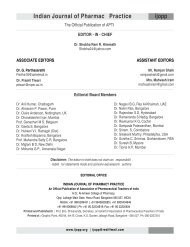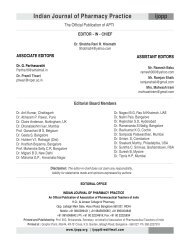Study of Drug Utilization Pattern of Glucocorticosteroid Drugs with ...
Study of Drug Utilization Pattern of Glucocorticosteroid Drugs with ...
Study of Drug Utilization Pattern of Glucocorticosteroid Drugs with ...
- No tags were found...
You also want an ePaper? Increase the reach of your titles
YUMPU automatically turns print PDFs into web optimized ePapers that Google loves.
Ankit P - <strong>Study</strong> <strong>of</strong> <strong>Drug</strong> <strong>Utilization</strong> <strong>Pattern</strong> <strong>of</strong> <strong>Glucocorticosteroid</strong> <strong>Drug</strong>s <strong>with</strong> Special Emphasis on their Immediate Adverse Effects in a Tertiary Care Teaching Rural Hospitalthree drugs which contain one drug as glucocorticoiddrugs (Table 4).Type <strong>of</strong>patientsglucocorticoids drugs prescribed to theIt was found that there were about 13 different types <strong>of</strong>glucocorticoid drugs were prescribed.The most frequent type was dexamethasone sodiumphosphate ( 66 out <strong>of</strong> 218 glucocorticoid drugs) (30.28%),administered via intravenous route.Other widely used glucocorticoid drugs were Budesonide49 (22.48%), Prednisolone 46 (21.10%), and Hydrocortisonesodium succinate 27 (12.39%) in frequency (Table 5).In most prescription, information about strength, duration<strong>of</strong> treatment, , frequency, route and area <strong>of</strong> application ( iftopical ) were adequately mentioned, while information onquantity to be used or purchased was inadequate.Adverse <strong>Drug</strong> Reactions (ADRs) <strong>of</strong> glucocorticoiddrugs observed in patientsChecklist <strong>of</strong> common drug reactions <strong>with</strong> glucocorticoiddrug use was prepared, which contain thirty one differentsymptoms/signs associated <strong>with</strong> use <strong>of</strong> these drugs.Out <strong>of</strong> 31 Adverse drug reactions likely to develop <strong>with</strong>glucocorticoid drug use, 13 adverse drug reactions wereobserved in our study.Amongst 13 different adverse drug reactions, muscularweakness and insomnia were observed in 45 & 25patients respectively.While the adverse drug reaction like fragile skin andpurple striae, osteoporosis, peptic ulcer, psychosis,hypomania or depression were observed in one patienteach.And adverse drug reaction like hyperglycemia, Cushingsyndrome, heart failure and posterior subcapsular cataractand fever were observed in 3, 4, 2, 2, 5 patientsrespectively (Table 6).DISCUSSIONAge wise distribution <strong>of</strong> patients shows that maximumnumber <strong>of</strong> patients were in 15-60 years age group.Amongst them, maximum number <strong>of</strong> patients weresuffering from condition related to respiratory system.There was no patient in 0-5 years age group, while onlyone patient in 5-14 years age group. It suggest thatpaediatric patients may require less use <strong>of</strong> glucocorticoiddrugs.Glucocorticoid drugs were maximally utilized in diseaserelated to the respiratory system. Respiratory conditionsare usually allergic and inflammatory, whereglucocorticoid drugs have major role to play. People inthe area are addicted to smoking or tobacco chewing andare therefore more prone to develop respiratoryproblems.Second seat for allergens on our body is skin. In 15 patientssuffering from dermatological conditions, glucocorticoidswere prescribed.In the study by Adrianne C. Feldstein et al, it is reportedthat the most frequent diagnoses associated <strong>with</strong>glucocorticoid use were chronic obstructive pulmonarydisease, 25.8%; asthma, 21.4%; rheumatoid arthritis,(2)17.2%.Amongst the 100 prescription collected, the total number<strong>of</strong> drug prescribed were 1081, i.e. a mean <strong>of</strong> 10.81 drugsper patient. It is obviously overprescribing.It may be due to patients were suffering from more thanone condition as well as they were having very longhistory <strong>of</strong> concomitant condition.To counteract common adverse reactions associated <strong>with</strong>glucocorticoids drug use, anti histaminic drugs andantiemetic drugs were prescribed to these patients, addingtotal number <strong>of</strong> drugs.Out <strong>of</strong> 1081 drugs prescribed, two hundred and eighteenwere from glucocorticoid group <strong>of</strong> drugs. It was foundthat use <strong>of</strong> the glucocorticoid drugs was rational(according to guidelines), they were used <strong>with</strong>inappropriate strength and gradually tapered <strong>of</strong>f, switchedfrom parenteral to oral medication.Dexamethasone sodium phosphate by intravenous route washighly prescribed amongst all glucocorticoid drugs. It is dueto its potency and longer duration <strong>of</strong> action, which playseffective role in acute settings.In spite <strong>of</strong> large number <strong>of</strong> prescribed drugs, lowincidence <strong>of</strong> adverse drug reactions were found in ourstudy.Low incidence is certainly due to rational use <strong>of</strong>glucocorticoid drugs. In addition, Patients were followedup to their hospital stay that was maximum 8 days formajority <strong>of</strong> patients.Indian Journal <strong>of</strong> Pharmacy Practice Volume 3 Issue 4 Oct - Dec, 2010 20
















